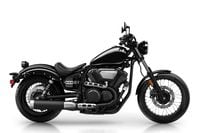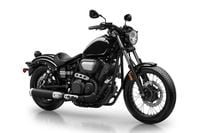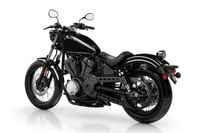On its website, Yamaha tags the Bolt as an “urban performance bobber,” and it certainly wears some of the hallmarks of the category with its minimal bodywork, compact chassis, and old-school tech, but the Bolt will appeal to almost any rider thanks to its friendly manners and torquey V-twin power. Yamaha’s (nee Star) midsize cruiser was introduced in 2013 and hasn’t changed much since then, soldering on with a fuel-injected, 942cc, air-cooled, SOHC V-twin engine and a spartan, no-fuss vibe. The more premium R-Spec model one-ups the base model with the addition of twin piggyback reservoir shocks, 12-spoke cast alloy wheels, and more in-depth paint options, but both offer a modern LED taillight and an LCD instrument cluster to bring a little high tech to the otherwise bare-bones feel.
Related: DYNO VIDEO: 2016 Star Bolt C-Spec
Its low saddle and compact feel will likely call out to shorter beginner and intermediate riders, though the Bolt can more than handle advanced pilots as well. A $7,999 buy-in is a pretty good motivator, and the better-equipped R-Spec model costs just $400 more.
The Bolt regularly makes “best cruiser value” lists because of its no-nonsense style, accessibility, as well as affordability, though its obvious competition, like Harley-Davidson’s Iron 883 and Triumph’s Street Twin models, offer a similarly stripped-down vibe and customizable platform at a reasonable price.
The Yamaha Bolt hasn’t had many updates at all since its launch in 2013, so changes to the 2020 model are exactly nil; in fact, even the price is unchanged.




/cloudfront-us-east-1.images.arcpublishing.com/octane/CZ5OM3E43ZEXJHY7LCYXCHLIKI.jpg)
/cloudfront-us-east-1.images.arcpublishing.com/octane/DF5T4K5KPZFJXFCTGPYR77PKJM.jpg)
/cloudfront-us-east-1.images.arcpublishing.com/octane/RMCT2KVQBJHBZMRTSLOVPMOILU.jpg)

/cloudfront-us-east-1.images.arcpublishing.com/octane/K45KB2XHQVA65DX7VN4ZSMT2BI.jpg)
/cloudfront-us-east-1.images.arcpublishing.com/octane/FNHXQQ56BRD7TO4YIJ453PNG2M.jpg)
/cloudfront-us-east-1.images.arcpublishing.com/octane/OIKJC4JA3ZH7BMKUGWYKBIY5FA.jpg)
/cloudfront-us-east-1.images.arcpublishing.com/octane/MT2SAEWY6FDXFBYSLDE3AEFDTM.jpg)
/cloudfront-us-east-1.images.arcpublishing.com/octane/66UPKPYVURBPRCP5HXSN56MEMM.jpg)
/cloudfront-us-east-1.images.arcpublishing.com/octane/EOREGDSRKFDCRJC6K3EDVHBGCE.jpg)
/cloudfront-us-east-1.images.arcpublishing.com/octane/42RF63Q3LVCMBP3DGTWXFYSMOA.jpg)
/cloudfront-us-east-1.images.arcpublishing.com/octane/XNVY3EVWZFCEVPUGJGAN633LXE.jpg)
/cloudfront-us-east-1.images.arcpublishing.com/octane/2PLTVHXY7FDSPFHKU5CFOC43ZY.jpg)
/cloudfront-us-east-1.images.arcpublishing.com/octane/B6M3WTRLFZGNXBEATNXPVGBBD4.jpg)
/cloudfront-us-east-1.images.arcpublishing.com/octane/4CMH3FI73BEM5D6MFYX42FLDSQ.jpg)
/cloudfront-us-east-1.images.arcpublishing.com/octane/RIHAPYNWU5H3XAOXNOPRWCBTQA.jpg)
/cloudfront-us-east-1.images.arcpublishing.com/octane/HU4NUBCL3VAFZA75VYRCMAUHVM.jpg)
/cloudfront-us-east-1.images.arcpublishing.com/octane/OB43AZK7TRA6XLZL5WRDVW2TDA.jpg)
/cloudfront-us-east-1.images.arcpublishing.com/octane/5G44Y3FXWNFSTEQKCA355PXOPU.jpg)

/cloudfront-us-east-1.images.arcpublishing.com/octane/XRI4GTLCVBA5NESASCBIR5LYQI.jpg)
/cloudfront-us-east-1.images.arcpublishing.com/octane/EF7566PXARGMBAOMLWTECYL3LE.jpg)
